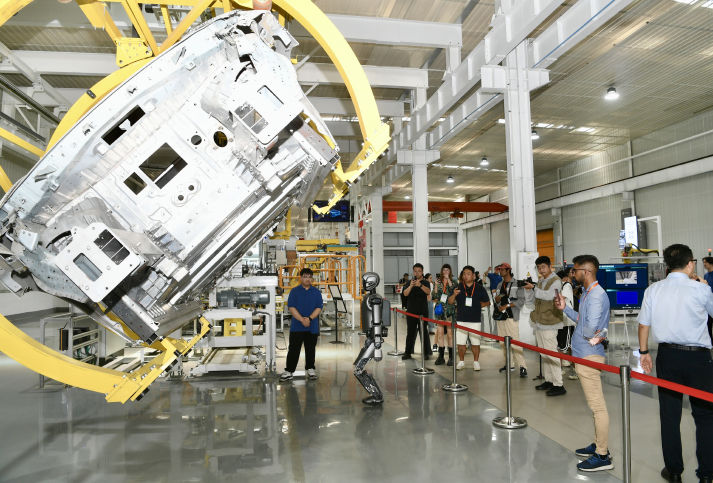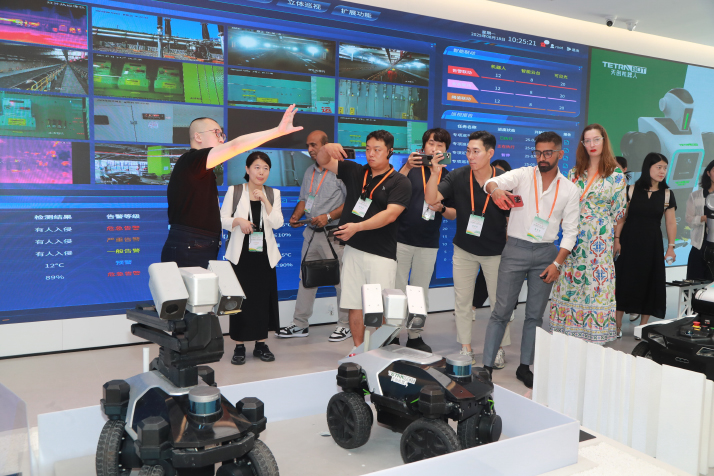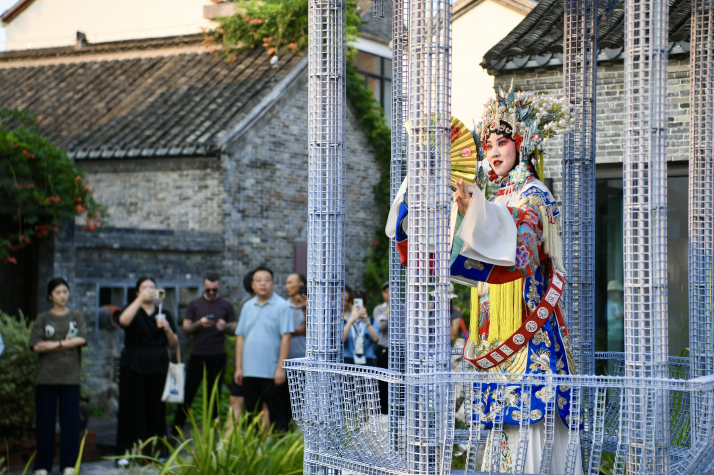| China |
| International media discover Jiangsu's culture, industry and innovative spirit on a cross-province tour | |
|
|
 Journalists visit Miracle Automation in Wuxi, Jiangsu, on August 19 (COURTESY PHOTO)
Known for centuries as the "land of fish and rice" and the "land of rivers and lakes," Jiangsu Province lies in the lower reaches of the Yangtze River, along China's eastern coastline. These names reflect a landscape shaped by fertile soil, crisscrossed with rivers, canals, lakes and reservoirs that have nourished and brought prosperity for generations. Today, Jiangsu, roughly the size of Iceland, stands as one of China's most developed regions. In 2024, the province's GDP reached 13.7 trillion yuan ($1.88 trillion), ranking second among China's provincial administrative regions, trailing only behind Guangdong Province. The province combines the natural wealth that has long defined it with a spirit of innovation and reform that continues to drive it forward. Its ancient towns still carry the elegance of traditional Chinese culture, while modern industrial zones and research parks testify to the province's place at the frontier of progress. This August, Jiangsu became the stage for a journey of discovery. From August 18 to 22, the New Dynamic Jiangsu: 2025 Global Media Tour brought together 19 journalists, including six from China and 13 from the Netherlands, Australia, Germany, Japan, the Republic of Korea (ROK), Brazil, India and Pakistan. Over five days, the delegation started their trip in the provincial capital city of Nanjing and followed a route from south to north, visiting cities such as Wuxi, Yancheng and Lianyungang. By stepping into factories, laboratories, cultural sites, and communities, the journalists engaged directly with local people and saw firsthand how Jiangsu is evolving. The journey offered not only a snapshot of the province's progress toward Chinese modernization, but also fresh perspectives on the province's culture.  A staff member introduces products to participants on the New Dynamic Jiangsu: 2025 Global Media Tour at TetraBOT in Nanjing, Jiangsu Province, on August 18 (COURTESY PHOTO)
Smart tech frontiers As one of China's leading manufacturing provinces, Jiangsu is pushing forward industrial upgrading through smart technologies. If its vast manufacturing base can be compared to a giant stage, then robots are undoubtedly among its brightest stars. In Nanjing, technology is taking center stage. Journalists toured Nanjing's Software Valley. Home to 328 AI-related companies and 50,000 AI professionals, the software base shapes a new landscape for the city's AI industry. One standout is TetraBOT. During the visit, the company showcased their robot products, already deployed in real factory environments, capable of taking over dirty, strenuous or hazardous tasks. The company also demonstrated robots designed for emergency response, industrial maintenance, and civil safety. Liu Danfu, assistant to the chairman of TetraBOT, said the company's products have been adopted by major enterprises in oil, chemical, mining and power sectors. Devinder Kumar, editor at the China-India Dialogue magazine, was impressed by the advanced AI applications and the smart, user-friendly design of the robots. He said Nanjing is becoming a hub for AI and robotics, combining rich cultural heritage with dynamic technological momentum. The journalists also visited the Turing AI Institute of Nanjing, founded in 2018 through a collaboration with Tsinghua University, one of China's top universities. It was established under the leadership of Yao Qizhi, an academician of the Chinese Academy of Sciences and recipient of the Turing Award, often regarded as the "Nobel Prize of Computing." The institute focuses on core technologies such as computer vision and natural language processing, applying them to fields ranging from robotics to smart city systems. Over the years, it has nurtured a thriving "Turing ecosystem," now home to 83 AI-driven companies spanning healthcare, finance, education, urban management and security. Also, with support in technology, funding, and market access, it has nurtured a generation of tech-driven startups. Lee Woojoong, a reporter at the ROK's Segye Times said, "Visiting here allowed me to see how cutting-edge technology can truly take root in society." At Miracle Automation in Wuxi, journalists visited a factory that had evolved from a township workshop into a listed company with breakthroughs in intelligent equipment, recycling and humanoid robotics. In the demonstration hall, humanoid robot Walker S1 impressed visitors with its ability to navigate autonomously, carry loads and complete sorting tasks with precision, showcasing how humanoid robots can handle complex industrial tasks. Song Kwangsub, a journalist from the ROK's Maeil Business Newspaper, said seeing the machines in action and learning about the company's data-driven approach deepened his impression of China's robotics sector. In Yancheng, the delegation visited Jiangsu Pudu Robotics Co. Ltd., where robots performing tasks such as delivering meals and transporting packages indoors were on display—machines already serving hotels, restaurants, and retail businesses in over 80 countries. Pedro Steenhagen, a Brazilian senior researcher and editor at Observa China, an online platform covering China-related issues for Portuguese-speaking countries, shared his experience of having meals delivered by a robot at a hotel, noting that the interactive system even called his room phone to remind him to pick up the order.
On August 22, the media delegation visits Chia-Tai Tianqing Pharmaceutical Group's workshop in Lianyungang, Jiangsu, to learn about pharmaceutical production (COURTESY PHOTO)
Other industrial strengths About 270 km from Nanjing, Yancheng, one of China's first pilot cities for carbon peaking, stretches along the Yellow Sea coast. At Dafeng Port Zero-Carbon Industrial Park, sunlight glints off solar panels powering offices and lighting, while the park's carbon intelligence center monitors energy use, carbon emissions and green electricity consumption across all enterprises in real time. In recent years, Dafeng Port has explored a "green electricity + hydrogen" development model, fostering industries such as green hydrogen and marine and synthetic biology, and supporting the transition of traditional sectors like steel, paper and chemicals. Muhammad Asghar, chief reporter for the Associated Press of Pakistan, said China's clean energy projects are supporting Pakistan's ecological efforts. He said Dafeng Port is well positioned to achieve zero-carbon emissions and expressed confidence in the goal. Beyond sustainable energy, Jiangsu is also advancing innovation in health and pharmaceuticals. In Lianyungang, Chia-Tai Tianqing Pharmaceutical Group operates six production lines in its second workshop, producing its glycyrrhizic acid products, derived from liquorice root, with 99.9-percent purity. Approved for three indications and included in several international clinical guidelines, the drug combines strong liver-targeting anti-inflammatory effects and high safety, contributing significantly to China's fight against Hepatitis B. With more than 80 percent of its research and development investment focused on innovation, the group now manages over 140 pipeline projects, including more than 70 novel drug candidates. Timothy Pope, an Australian working for the International Communications Center of Shanghai Dragon TV, said that seeing China produce so many new therapies was encouraging, and with global collaboration, more patients will benefit from these innovations. The journey also introduced journalists to Jiangsu's traditional industries. At Donghai Crystal City in Lianyungang, the world's largest crystal market, age-old craftsmanship is embracing digital channels. Rows of glittering crystal products are not only sold on-site but also streamed live to buyers around the world, illustrating how Jiangsu's traditional industries are connecting to global markets. Japanese anchor Ohori Rio, from the Center for the Asia-Pacific, China International Communications Group, showed a newly purchased crystal bracelet, noting its affordability and saying she would like to buy more when browsing online platforms.  A journalist paints a clay panda in Wuxi, Jiangsu, on August 19 (COURTESY PHOTO)
Cultural hubs The journalists also explored the cultural heritage of Jiangsu. At the Huishan Clay Figurine Museum in Wuxi, the delegation admired masterpieces ranging from traditional opera characters to modern creative designs. In hands-on sessions, senior craftsman Zhou Lu from Huishan Clay Figurine Factory taught reporters how to paint clay pandas. Huishan clay figurines have a history of more than 400 years. Known for their compact yet full-bodied forms, graceful lines, vivid colors and imaginative designs, they serve as toys, decorative ornaments, and collectible art. Kumar said he was deeply impressed by the artisans' dedication. Experiencing clay painting firsthand brought him joy and inspired him to explore more of China's traditional culture, he added. As night fell, the reporters caught a glimpse into another aspect of Jiangsu. In Wuxi's Huishan Ancient Town, visitors stood on stone bridges over the Grand Canal, listening to the lilting local tune while watching boats glide gently across the water. Crowds gathered along the riverbanks to enjoy performances. Soul of the Moon, an immersive show, blends Wuxi's rich historical culture with contemporary performing arts. Among the highlights was a show paying tribute to visually impaired local artist Hua Yanjun, best known as Abing, China's most famous erhu player, who earned a living performing on the streets and endured decades of hardship. The erhu is a traditional stringed instrument. The show brought both the sorrow and hope in Abing's musician masterpiece, The Moon Reflected on the Second Spring, to life, presenting a century-old folk legacy to a modern audience.  Visitors watch an opera performance at Huaiju Town in Yancheng, Jiangsu, on August 21 (COURTESY PHOTO)
The journey into traditional culture continued in Yancheng at Huaiju Town, a cultural hub built to preserve and showcase Jiangsu's intangible heritage Huaiju Opera, and as part of a cultural and tourism integration initiative. Inspired by the settings of Huaiju Opera, also known as Jianghuai Theater, which gained popularity around a century ago, the town features historical streets, architecture, waterways and village life, while creating new cultural experiences. The entire town is a big stage for visitors to have an immersive experience of the local opera. Through visits to these cultural hubs, journalists learned Jiangsu's efforts to revive intangible heritage and share the province's cultural richness with visitors. "Usually, we only see major cities like Shanghai, Beijing or Shenzhen show a modern, internationalized side. But by visiting smaller cities, you get to experience the real diversity of China, its culture, folk festivals, food, clothing and traditions, while also seeing its rapid technological development," Kumar told Beijing Review. (Printed Edition Title: Rivers, Rice and Revolution) Copyedited by G.P. Wilson Comments to liqing@cicgamericas.com |
|
||||||||||||||||||||||||||||||
|